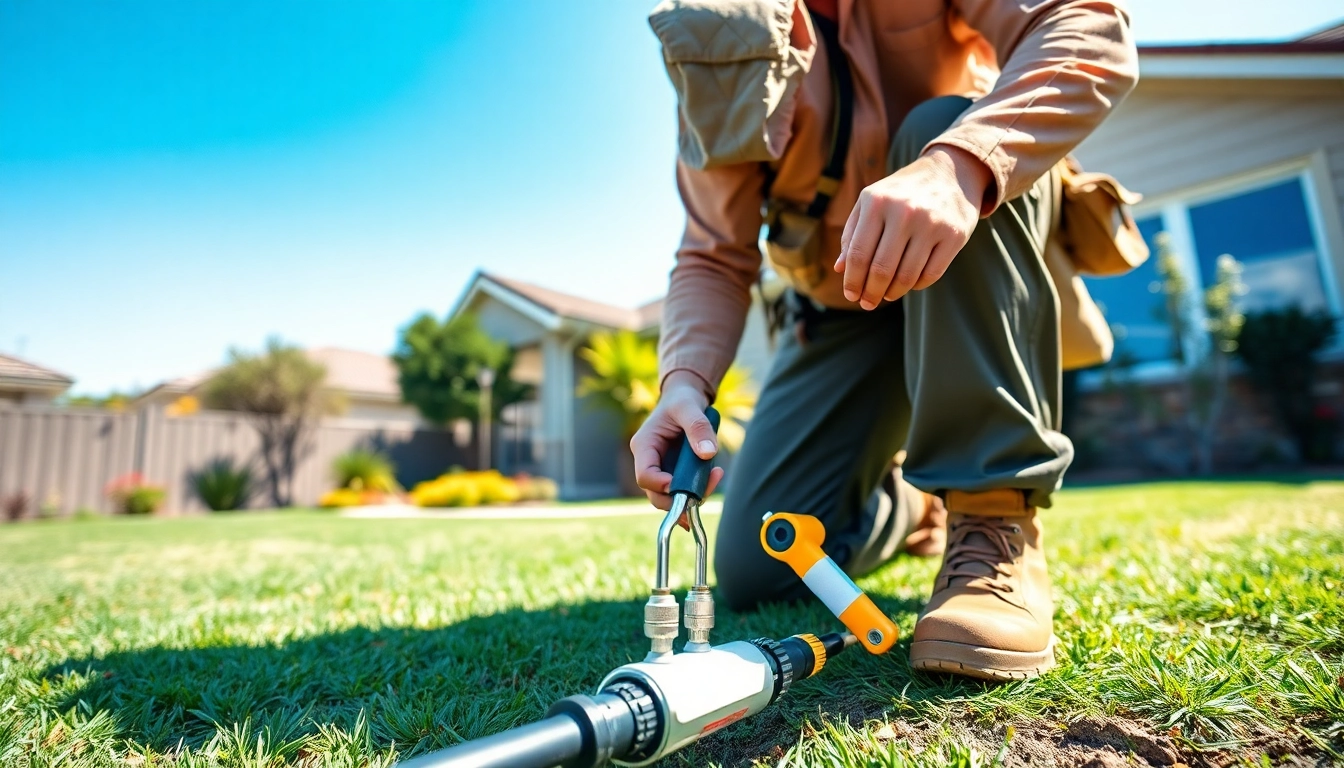Understanding Termite Reticulation Systems
What Is a Termite Reticulation System?
A termite reticulation system is an advanced method of pest control designed to protect property from termite infestations. This system consists of a network of pipes installed underground, typically surrounding the perimeter of a building. These pipes are connected to terminals or access points, allowing pest control professionals to deliver termiticidal chemicals directly to the areas where termites are most likely to enter. The primary goal of these systems is to create a continuous barrier of protection around the foundation of your home, ensuring that termites cannot breach this line of defense.
Benefits of Using a Reticulation System
Utilizing a termite reticulation system offers numerous benefits to homeowners who seek long-term protection against termite damage:
- Effective Barrier: The system provides a consistent and efficient barrier against termites, reducing the risk of an infestation.
- Ease of Application: Refills can be easily administered through the access points without disturbing the landscape or foundation.
- Long-Term Protection: These systems can last for years when maintained properly, making them a valuable investment.
- Reduced Chemical Exposure: Targeted applications lead to minimal chemical use, reducing environmental impact.
How a Reticulation System Works
The operation of a termite reticulation system is quite straightforward. When installed, the pipes are filled with a chemical treatment that is effective against termites. Over time, or as a result of rain or evaporation, these chemicals diminish in potency. Regular refills of these substances maintain their efficacy, ensuring that the property remains protected. The system typically utilizes advanced formulation techniques to control the amount of product being dispensed, ensuring that it remains in effective concentrations. Homeowners should consult with pest control professionals to determine the best types of chemicals and the ideal schedules for refilling.
Importance of Termite Reticulation System Refills
Why Regular Refills Are Necessary
Termite reticulation system refills are crucial for maintaining an effective barrier against termites. As noted, the chemicals used within the system lose their potency over time, generally requiring refills every 3 to 8 years, depending on the specific chemical treatment used. This refilling process is essential in ensuring that the barrier remains strong and that termites are effectively deterred from entering the property.
Factors Influencing Refill Frequency
Several factors can influence how often you may need to refill your termite reticulation system:
- Environmental Conditions: Areas with high rainfall or humidity may require more frequent refilling due to accelerated chemical degradation.
- Soil Composition: The type of soil and its permeability can also affect how long the chemical lasts. Sandy soils may lead to faster dispersion, while clay can provide slower release.
- Usage of Chemicals: Different formulations have varying lifespans and effectiveness; some may require more frequent replenishment than others.
Consequences of Neglecting Refills
Neglecting to refill your termite reticulation system can lead to several negative consequences, including:
- Increased Termite Risk: Without the active chemical barrier, your home becomes vulnerable to termite attacks, potentially leading to severe structural damage.
- Costly Repairs: Failure to maintain proper refills can result in expensive repair bills as termite damage accumulates, which can far exceed the cost of regular maintenance.
- Insurance Implications: Some home insurance policies may not cover damages resulting from pest infestations if it is determined that the homeowner neglected their maintenance obligations.
How to Successfully Refill Your Termite Reticulation System
Steps for DIY Refilling
Refilling a termite reticulation system is a task that some homeowners might consider handling themselves. However, this requires a certain degree of expertise and knowledge to ensure it is done correctly. Here are the steps to follow:
- Gather Required Tools: You will need a refilling gun, the appropriate termiticide, a hose, and possibly a wrench to detach existing caps.
- Locate Access Points: Identify the access ports on your reticulation system. These are usually marked and easily accessible.
- Prepare the Termiticide: Mix the chemical according to the manufacturer’s instructions. Accuracy in this step is critical to ensure safety and effectiveness.
- Refill the System: Using the refilling gun, insert the nozzle into the access points and begin administering the termiticide until the desired amount has been added.
- Seal Access Points: Ensure all access points are properly sealed after refilling to prevent any leakage.
Hiring a Professional vs. DIY Refills
While some homeowners may opt for a DIY refill, hiring a professional pest control technician can offer several advantages:
- Expertise: Professionals bring valuable training and experience, ensuring the task is performed effectively and safely.
- Proper Handling of Chemicals: Professionals are typically more knowledgeable about the chemicals used and can handle them safely, reducing risks.
- Inspection Services: During a refill, a pest control professional can conduct a thorough inspection of your home to check for any other potential infestations or damage.
Tools and Materials Needed for Refills
To successfully refill your termite reticulation system, you will need the following tools and materials:
- Refilling gun
- High-quality termiticide
- Protective gear (gloves, goggles, mask)
- Measuring devices for the chemical
- Wrench (if needed for caps)
- Water source for diluting the chemical (if necessary)
Costs and Budgeting for Termite Reticulation Refills
Average Cost of Refills
The cost to refill a termite reticulation system can vary significantly based on a range of factors including the type of chemicals used, the size of the system, and labor costs if a professional is hired. Typically, homeowners can expect to spend from $150 to $500 per refill appointment. Factors influencing the total price include:
- Size of the property
- Type of chemicals selected
- Geographic location
Understanding Return on Investment
Investing in a termite reticulation system and maintaining it with regular refills is not only a smart choice for preventing infestations, but it can also provide significant financial returns in terms of cost savings on repairs and peace of mind. A well-maintained system can enhance the value of your property by protecting its structural integrity from potential termite damage, which can be extensive and expensive to repair.
Cost-Saving Tips for Maintenance
Staying budget-conscious while ensuring your termite reticulation system remains effective is crucial. Here are some practical tips for saving money:
- Regular Inspections: Schedule routine inspections to catch and resolve potential issues early on before they escalate into significant problems.
- Compare Service Providers: Look around for competitive pricing and service packages when hiring pest control professionals for refills.
- Stay Informed: Educate yourself on the various chemical options available and how they align with your budget and efficacy needs.
- Proper Maintenance: Ensuring the surrounding landscape and foundation are well-maintained can prevent moisture buildup, keeping the chemicals effective for longer.
Best Practices for Maintaining Your Termite Reticulation System
Routine Inspections and Maintenance
One of the most effective ways to maintain a termite reticulation system is through regular inspections. Homeowners should aim for at least annual inspections to assess the condition of the system and the effectiveness of the chemicals. Any observed abnormalities or damages should be corrected immediately to restore the protection barrier.
Updating Your System to New Standards
As technology and formulations evolve, it is vital to stay updated with the latest advancements in termite prevention systems. Homeowners should consider upgrading components of their reticulation systems when new, more effective options become available. Consult with pest control professionals about the best options for your property.
Clarifying Misconceptions About Termite Treatment
There are several misconceptions surrounding termite treatment, and clarifying these can help homeowners make informed decisions. For instance, many believe that conventional treatments are sufficient without a reticulation system. However, a reticulation system significantly enhances home protection, especially when it comes to long-term defense strategies.
Additionally, the misconception that professional treatment is not necessary is misleading; DIY attempts can often lead to subpar results and greater risk of infestations. Understanding the blend of professional and DIY practices is essential in achieving optimal results.
In conclusion, implementing a termite reticulation system and adhering to a regimen of regular refills and maintenance significantly positions homeowners to protect their assets effectively. Whether opting for DIY refills or professional assistance, the overarching goal remains constant: to maintain a strong line of defense against the devastating impact of termite infestations. For those interested in learning more about termite reticulation system refills, researching and consulting with experts can yield valuable insights relevant to your unique situation.



